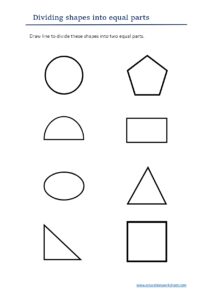Learn Fractions by Math Fractions Worksheets
Math Fractions Worksheets
Learning fractions through math fractions worksheets can be an effective way to grasp the concept. Here’s a step-by-step guide on how to learn fractions using worksheets:
-
Understand the Basics:\
- Before you start working on fractions worksheets, ensure you have a fundamental understanding of what fractions are. Fractions represent parts of a whole. The top number (numerator) tells you how many parts you have, while the bottom number (denominator) tells you the total number of equal parts that make up the whole.
- Gather Materials: You’ll need a supply of worksheets or access to online resources that provide fraction problems. You can find a variety of worksheets online, including printable versions or interactive ones.
- Start with Simple Fractions: Begin with basic fractions, such as halves (1/2), thirds (1/3, 2/3), and quarters (1/4, 3/4). These are often used in everyday life and provide a good foundation.
- Practice Identifying Fractions: Begin by practicing the identification of fractions. Given a picture or a set of objects, identify the fraction represented. For example, if you see a pizza divided into eight slices with three slices eaten, what fraction of the pizza remains (5/8)? These exercises help you visually understand fractions.
- Learn Fraction Equivalents: Fractions can be equivalent to one another. For instance, 1/2 is equivalent to 2/4 and 4/8. Practice converting fractions to their simplest forms and finding equivalent fractions.
- Addition and Subtraction: Move on to addition and subtraction of fractions with the same denominator. For example, 1/4 + 2/4 = 3/4. Work on problems that involve both proper and improper fractions.
- Multiplication and Division: Once you’re comfortable with addition and subtraction, learn how to multiply and divide fractions. Practice multiplying fractions (e.g., 1/3 x 2/5) and dividing fractions (e.g., 3/4 ÷ 1/2).
- Mixed Numbers: Understand mixed numbers, which are combinations of whole numbers and fractions (e.g., 2 1/3). Learn how to convert mixed numbers to improper fractions and vice versa.
- Word Problems: Solve word problems that involve fractions. This helps you apply your fraction skills to real-life situations, such as cooking, dividing objects, or measuring.

Math Fractions Worksheets - Math Fractions Worksheets
-
Practice Regularly:
- Consistent practice is key to mastering fractions. Dedicate time to work on fractions worksheets regularly. Gradually increase the complexity of the problems as you become more comfortable with the basics.
- Seek Help When Needed: If you encounter difficulties or have questions, don’t hesitate to seek help from a teacher, tutor, or online resources. There are many educational websites and videos that can provide additional explanations and examples.
- Self-Assessment: After completing worksheets, review your answers and identify any mistakes. Correct them and try to understand where you went wrong.
- Use Online Tools: There are online fraction calculators and practice websites that can generate fractions worksheets and provide instant feedback.
Remember that learning fractions takes time and practice, so be patient with yourself. As you gain confidence and competence with fractions, you’ll find them to be a valuable tool in various mathematical and real-life contexts.
- Seek Help if Needed: If you encounter difficulties with specific concepts or problems, don’t hesitate to ask for help from a teacher, tutor, or a reliable online resource.
- Real-life Application: Apply your knowledge of fractions to real-life situations. For example, use fractions when dividing a pizza, baking, or sharing candies with friends.
- Track Your Progress: Keep a record of the worksheets you’ve completed and your performance. This can help you see your progress over time and identify areas that need more practice.
Remember that learning fractions can be challenging, and it’s okay to take your time and practice at your own pace. The key is consistent practice and a deep understanding of the fundamental concepts
.Practice Proper Vocabulary: Ensure you understand the vocabulary associated with fractions, such as numerator, denominator, proper fractions, improper fractions, mixed numbers, etc.

